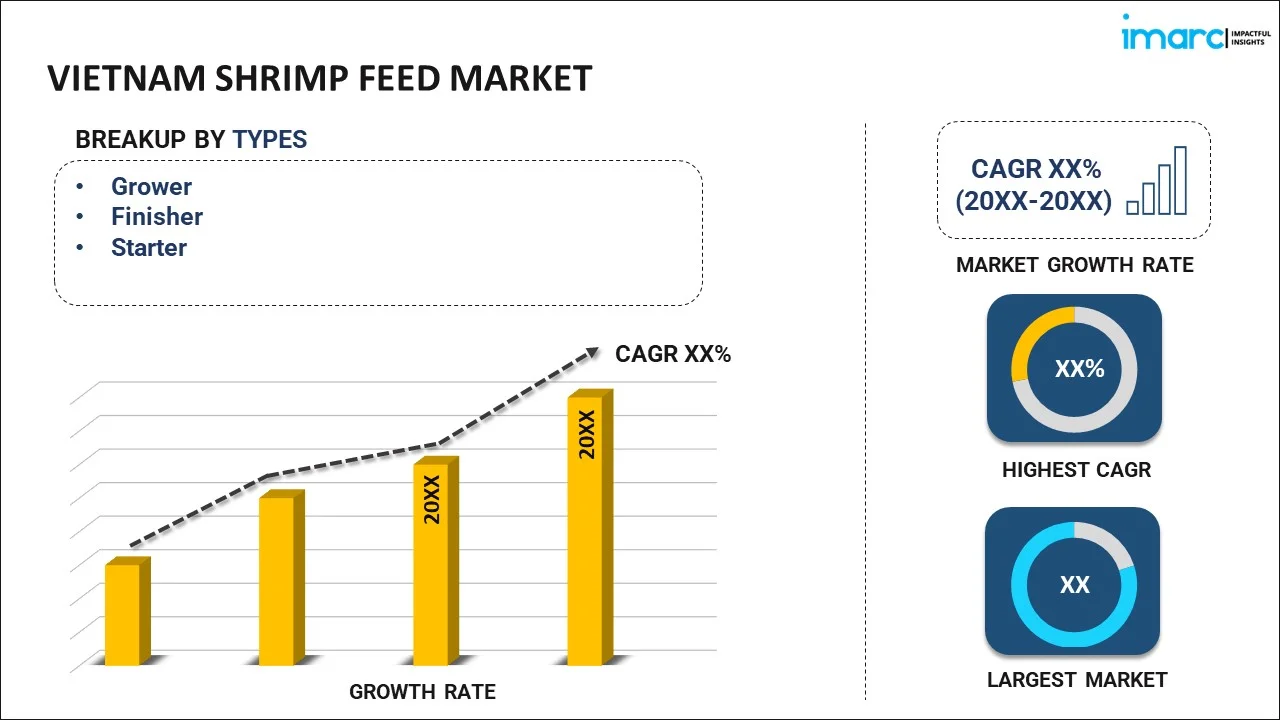
Vietnam Shrimp Feed Market Report by Type (Grower, Finisher, Starter), Ingredients (Soybean Meal, Fish Meal, Wheat Flour, Fish Oil, and Others), Additives (Vitamin and Protein, Fatty Acid, Antioxidant, Feed Enzyme, Antibiotics, and Others) 2025-2033
Market Overview:
The Vietnam shrimp feed market size reached 1.7 Million Tons in 2024. Looking forward, IMARC Group expects the market to reach 3.2 Million Tons by 2033, exhibiting a growth rate (CAGR) of 7.4% during 2025-2033.
|
Report Attribute
|
Key Statistics
|
|---|---|
|
Base Year
|
2024
|
|
Forecast Years
|
2025-2033
|
|
Historical Years
|
2019-2024
|
|
Market Size in 2024
|
1.7 Million Tons |
|
Market Forecast in 2033
|
3.2 Million Tons |
| Market Growth Rate 2025-2033 | 7.4% |
Shrimp feed refers to the adequate food formulation required for producing healthy shrimps. It is formulated to meet the nutritional requirements of farmed shrimps and includes vitamins, minerals, amino acids, fatty acids, etc. Apart from the fulfillment of the nutritional requirements, shrimp feed also plays an important role in improving the immunity of shrimps against diseases. There are various types of shrimp feed available in the market which include starter grade, grower grade and finisher grade. A key factor driving the demand of shrimp feed in Vietnam is the rising demand of shrimps in the country. Vietnam represents one of the world’s largest producers and exporters of shrimps across the globe. Shrimp, currently represents the most important export product in the country and accounted for around 50% of the total seafood exports. Other factors driving the demand of shrimp feed in Vietnam include growth of the shrimp aquaculture industry, rising demand for value added feeds, advancement in feed manufacturing technologies, etc.
IMARC Group’s latest report provides a deep insight into the Vietnam shrimp feed market covering all its essential aspects. This ranges from macro overview of the market to micro details of the industry performance, recent trends, key market drivers and challenges, SWOT analysis, Porter’s five forces analysis, value chain analysis, etc. This report is a must-read for entrepreneurs, investors, researchers, consultants, business strategists, and all those who have any kind of stake or are planning to foray into the Vietnam shrimp feed market in any manner.
Key Market Segmentation:
IMARC Group provides an analysis of the key trends in each sub-segment of the Vietnam shrimp feed market report, along with forecasts for the period 2025-2033. Our report has categorized the market based on type, ingredients and additives.
Breakup by Type:

- Grower
- Finisher
- Starter
Breakup by Ingredients:
- Soybean Meal
- Fish Meal
- Wheat Flour
- Fish Oil
- Others
Breakup by Additives:
- Vitamin and Protein
- Fatty Acid
- Antioxidant
- Feed Enzyme
- Antibiotics
- Others
Value Chain Analysis
Key Drivers and Challenges
Porters Five Forces Analysis
PESTEL Analysis
Government Regulations
Competitive Landscape
- Competitive Structure
- Key Player Profiles
Report Coverage:
| Report Features | Details |
|---|---|
| Base Year of the Analysis | 2024 |
| Historical Period | 2019-2024 |
| Forecast Period | 2025-2033 |
| Units | Million USD, Million Tons |
| Segment Coverage | Type, Ingredients, Additives |
| Customization Scope | 10% Free Customization |
| Post-Sale Analyst Support | 10-12 Weeks |
| Delivery Format | PDF and Excel through Email (We can also provide the editable version of the report in PPT/Word format on special request) |
Key Questions Answered in This Report
The Vietnam shrimp feed market reached a volume of 1.7 Million Tons in 2024.
We expect the Vietnam shrimp feed market to exhibit a CAGR of 7.4% during 2025-2033.
The introduction of high-quality shrimp feed with improved water stability, nutrition density, hygienic raw materials, palatability, etc., is primarily driving the Vietnam shrimp feed market.
The sudden outbreak of the COVID-19 pandemic had led to the implementation of stringent lockdown regulations across the nation, resulting in the temporary halt in numerous aquaculture practices, thereby negatively impacting the Vietnam shrimp feed market.
Based on the type, the Vietnam shrimp feed market can be categorized grower, finisher, and starter. Currently, grower accounts for the majority of the total market share.
Based on the ingredients, the Vietnam shrimp feed market has been segregated into soybean meal, fish meal, wheat flour, fish oil, and others. Among these, soyabean meal currently exhibits a clear dominance in the market.
Based on the additives, the Vietnam shrimp feed market can be bifurcated into vitamin and protein, fatty acid, antioxidant, feed enzyme, antibiotics, and others. Currently, vitamin and protein holds the largest market share.
Need more help?
- Speak to our experienced analysts for insights on the current market scenarios.
- Include additional segments and countries to customize the report as per your requirement.
- Gain an unparalleled competitive advantage in your domain by understanding how to utilize the report and positively impacting your operations and revenue.
- For further assistance, please connect with our analysts.
 Inquire Before Buying
Inquire Before Buying
 Speak to an Analyst
Speak to an Analyst
 Request Brochure
Request Brochure
 Request Customization
Request Customization




.webp)




.webp)












